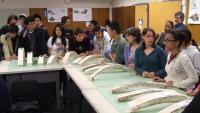This week I have been enjoying a couple of home projects. If you came by my house you would find me on the back porch working on a table top I am building, or doing some minor body work on a 1993 Ford Ranger I bought a few weeks ago. This summer, I will be spending several weeks with my teenage sons laying the foundation for a cabin in the woods of Mendocino County. There is something deeply satisfying about these projects, and it has me wondering what we could learn from this. I am rewarded with concrete evidence of my work, and something intrinsically useful results.
When my sons were in pre-school, one of their favorite teachers was a woman named Emily. They called her “The project-er,” because every day she would come up with a new project for them to do. They would make masks out of paper plates, or animals out of cardboard tubes. They loved to build things with her, and were always happy to go to school, never knowing what the next project would be.
My nephew, Patrick Cody-Carrese, has been experiencing a similar thrill at his school, Oakland Technical High School’s Engineering Academy.

The students competed to build a bridge out of identical quantities of balsa wood and glue, and then gathered to test the creations. The winning bridge supported almost 100 pounds of weight without breaking. These students worked long hours to complete their bridges.

Patrick says, “Working this way helped me understand all the stuff we have been reading about in the books much better. It was hard building the bridge because you really have to be careful with the angles. You only get a limited supply of balsa wood, so if you cut it wrong you are going to be in trouble.”
The first lesson I draw from this is the direct value of hands-on projects for our students. These projects allow them to apply book-learning to real world materials.

Apple Learning Interchange.
In courses like these students may learn for the first time where their passions lie. Students who may not be particularly gifted in math, may discover a talent working with their hands, or taking photographs. We need more diverse learning opportunities, because our students are not all from the same mold.
The second lesson I draw applies more to our work as teachers.

One of the things I love about teaching is the workshop of the classroom. As a teacher, I love the chance to come up with an original approach to presenting a concept to my students. One year I found caterpillars on the fennel bushes growing outside. We measured those caterpillars every day, and graphed their growth as a class -- and then watched as the beautiful swallowtail emerged from its cocoon.
Another year we hatched chicken eggs in the class, and as a math assignment, I had the students design chicken coops and do scale drawings of them. One student even built a scale model at home. This kind of spontaneous challenge is what brings the classroom to life. Unfortunately some policymakers seem to think the best teaching is standardized, and that we should all simply figure out the best set of lessons and have everyone copy them. This standardization removes the creative challenge from teaching, and reduces the level of engagement for students and teachers alike. The best teaching is like a never-ending series of projects for the imaginative teacher.
Summer beckons us all to get outside and enjoy the sun, and dig into some fun projects we have been putting off. Don’t let that project-er spirit die in the shortening days of the fall. Bring the projects back to the classroom, and everybody will be happier.
What is your project this summer? What projects have you brought to life in your classroom?
Bridge project photos by Oakland Tech parent Rhita Williams, used by permission.
Swallowtail photo by Anthony Cody